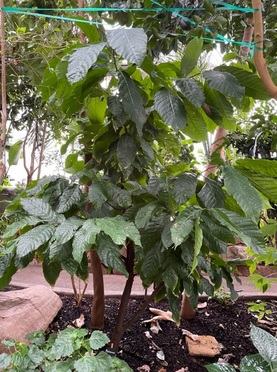Cocoa Plant
Theobroma cocoa
Family: Malvaceae | Place of Origin: South American tropical regions
Origins and history:
From the Amazons of South America, the cocoa plant has moved its way up into the regions of Mexico. The earliest recorded use of cocoa was in Honduras during about 1000 BCE. This evidence was found after a chemical analysis of vessels revealed the use of cocoa as a drink. By 1000 AD the use of cocoa had expanded all the way into what is today, known as New Mexico.
In Central America the use of chocolate was very important in the Aztec and Mayan civilizations. The Aztecs considered the cocoa plant to be sent to them by the Gods. It was considered an upper-class extravagance and wasn’t drank by every member of society, however, the beans were readily accessible and even used as currency for trade among the Aztec people. Cortez was the Spanish explorer that noted the importance of cocoa after it was offered to him by Montezuma as a sign of respect. He then brought some cocoa back to Europe in 1528.

Identification characteristics
The cocoa plant has large unlobed leaves that are approximately 4-16 inches long. The leaf arrangement is alternate which means each node only has one leaf and they alternate on different sides of the branch. The cocoa tree produces flowers year-round which are small, white, regular, cauliflorous flowers. Cauliflorous means they are produced directly on the trunk of the plant. This tree can grow up to 9 meters tall which is fairly small in its natural environment and it’s considered an understory tree. Pods form from the flowers and are large leathery seed pods which are about 6-12 inches long by 3-4 inches wide and can contain up to 20-60 seeds in each pod. These pods take about 3 months to fully develop and have a red and yellow color to them.
Uses and preparation
The preparation begins with harvesting the Cocoa pods. This is done once all of the pods have reached maturity and have a red and yellow color to the entire pod. After they are taken down, they are cracked open, and the seeds are removed. The seeds are left to ferment for about 5-6 days, this is where the chocolate scent is released. After the beans have fermented, they are then roasted, and the shells are removed to expose just the nibs. The shells have been known to contain higher levels of theobromine as well as heavy metals and other toxins mostly acquired during improper drying and fermenting processes. Although, there are ways to remove harmful compounds now, the shells weren’t always safe and are now being used as agricultural fertilizers and even in some food recipes after being treated. Once the nibs have been isolated, they are ground into a very fine slurry. If the moisture and fats aren’t removed it forms the Theobroma drink that was so famously drank by the ancient kings, however, once the moisture and fats are removed it forms a cocoa powder used in baking and many other processes including chocolate.
Another use for chocolate is from the active ingredients found in the cocoa bean. There are a number of pharmaceutical uses including antibacterial, antioxidant, anti-inflammatory, antifungal, and chemo-preventive properties. The Function of the cocoa pods goes beyond even consumption. One of the largest sources of waste is the shells of the cocoa beans and those can have Theobroma extracted from them and used to caffeinate drinks. The remnants of the shells are then sold as agricultural mulch due to their high density of beneficial nutrients to the soil.